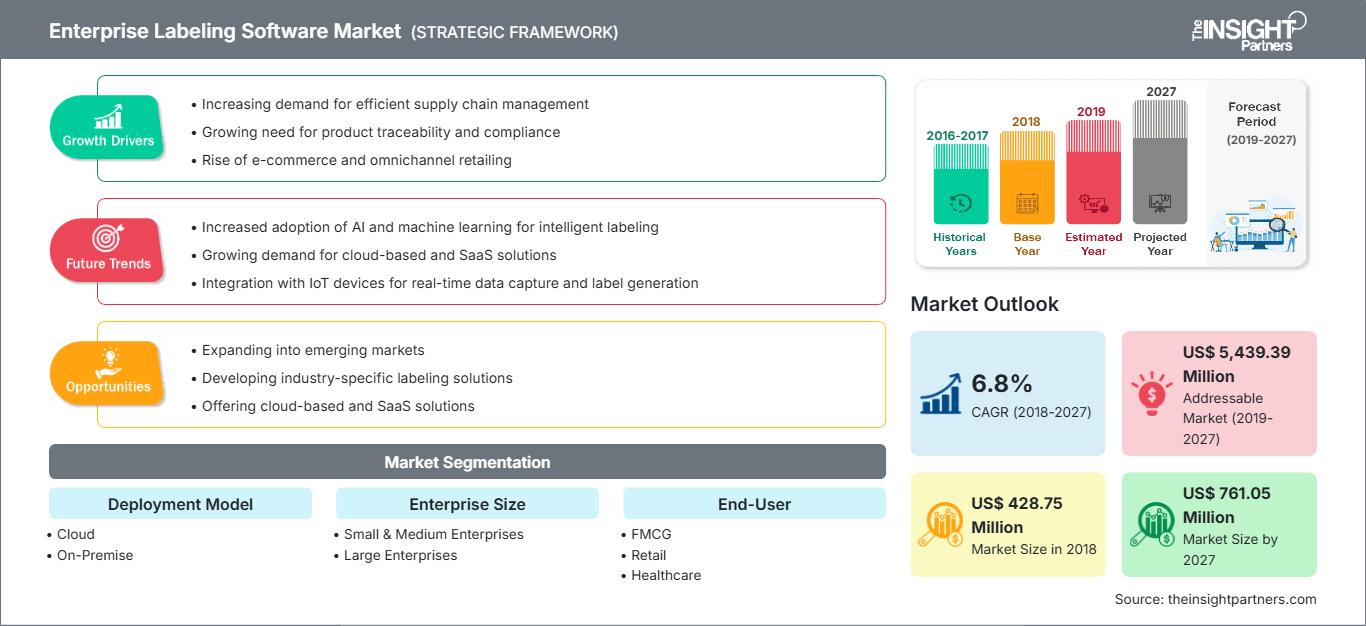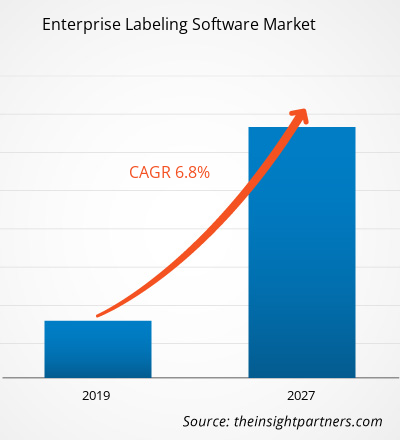Der Markt hatte im Jahr 2024 einen Wert von 482,31 Millionen US-Dollar und soll bis 2031 auf 799,95 Millionen US-Dollar anwachsen; für den Zeitraum 2025–2031 wird eine durchschnittliche jährliche Wachstumsrate (CAGR) von 7,8 % erwartet.
Marktanalyse für Etikettierungssoftware für Unternehmen
Mehrere Faktoren prägen den Markt für Etikettierungssoftware für Unternehmen dynamisch. Die zunehmende Komplexität von Lieferketten und strenge regulatorische Anforderungen veranlassen Unternehmen zur Einführung automatisierter Etikettierungslösungen. Anpassbarkeit, Integrationsfunktionen und benutzerfreundliche Oberflächen sind die wichtigsten Unterscheidungsmerkmale für Anbieter in einem wettbewerbsintensiven Markt. Die größten Herausforderungen bestehen darin, die vielfältigen branchenspezifischen Anforderungen zu erfüllen und die Kompatibilität mit bestehenden Systemen zu gewährleisten. Darüber hinaus beeinflusst die Einführung von Cloud-Lösungen den Markt, da sie Fernzugriff und skalierbare Bereitstellungen ermöglicht; Kaufentscheidungen werden jedoch maßgeblich von Bedenken hinsichtlich der Datensicherheit beeinflusst. Partnerschaften zwischen Anbietern von Etikettierungssoftware und Hardwareherstellern führen zu Paketangeboten, die die Attraktivität der Wertversprechen steigern. Kontinuierliche Innovationen werden durch den Kundenbedarf an Echtzeit-Datenanalysen und die Rückverfolgbarkeit von Etiketten vorangetrieben.
Marktübersicht für Etikettierungssoftware für Unternehmen
Der Markt für Etikettierungssoftware für Unternehmen bietet hochskalierbare, automatisierte Lösungen, die Prozesse in verschiedenen Branchen wie Logistik, Gesundheitswesen, Einzelhandel und Fertigung optimieren. Diese Software ist ein Eckpfeiler moderner Unternehmen und ermöglicht es ihnen, Präzision, Konformität und Produktivität durch die digitale Erstellung, den Druck und die Verwaltung von Etiketten zu gewährleisten. Der Markt für Etikettierungssoftware für Unternehmen bietet skalierbare, automatisierte Lösungen zur Prozessoptimierung in verschiedenen Branchen wie Fertigung, Logistik, Einzelhandel und Gesundheitswesen. Diese Softwarelösungen tragen zur Genauigkeit, Compliance und Effizienz bei, indem sie Unternehmen die digitale Erstellung, den Druck und die Verwaltung von Etiketten ermöglichen. Unternehmen setzen Etikettierungssoftware zunehmend ein, um menschliche Fehler zu reduzieren und operative Arbeitsabläufe zu verbessern. Treiber dieser Entwicklung sind die steigende Nachfrage nach Rückverfolgbarkeit, Einhaltung gesetzlicher Vorschriften und effektivem Produktinformationsmanagement. Die Integration mit ERP- und Supply-Chain-Management-Systemen fördert die Verbreitung dieser Software.
Sie erhalten eine kostenlose Anpassung aller Berichte – einschließlich Teilen dieses Berichts, Länderanalysen und Excel-Datenpaketen – sowie attraktive Angebote und Rabatte für Start-ups und Universitäten.
Markt für Etikettierungssoftware für Unternehmen: Strategische Einblicke

- Ermitteln Sie die wichtigsten Markttrends dieses Berichts.Diese KOSTENLOSE Probe beinhaltet eine Datenanalyse, die von Markttrends bis hin zu Schätzungen und Prognosen reicht.
Markttreiber und Chancen für Software zur Unternehmenskennzeichnung
Markttreiber:
- Einhaltung gesetzlicher Bestimmungen: Strenge Vorschriften erfordern eine genaue und standardisierte Kennzeichnung, um die Produktsicherheit und Rückverfolgbarkeit zu gewährleisten.
- Komplexität der Lieferkette: Wachsende globale Lieferketten erfordern ein effizientes Etikettenmanagement, um Transparenz zu gewährleisten und Fehler zu reduzieren.
- Digitale Transformation: Unternehmen setzen auf automatisierte Lösungen, um die manuelle Etikettierung zu ersetzen und die betriebliche Effizienz zu steigern.
Marktchancen:
- Integration von KI und maschinellem Lernen: Durch den Einsatz von KI lassen sich die Genauigkeit der Beschriftungen verbessern und die Fehlererkennung in Beschriftungsprozessen automatisieren.
- Expansion in Schwellenländer: Die zunehmende Industrialisierung in Schwellenländern eröffnet neue Kundengruppen für Etikettierungslösungen.
- IoT-Konnektivität: Die Verbindung von Etikettierungssoftware mit IoT-Geräten ermöglicht Echtzeitüberwachung und intelligenteres Lieferkettenmanagement.
Marktbericht: Segmentierungsanalyse für Enterprise-Etikettierungssoftware
Der Markt für Etikettierungssoftware für Unternehmen ist wie folgt segmentiert:
Durch das Anbieten:
- Software: Der wachsende Bedarf an Präzision und die Automatisierung von Etikettierungsverfahren treiben die Nachfrage nach leistungsfähigeren Softwarelösungen voran, die das Design, die Verwaltung und den Druck von Etiketten vereinfachen.
- Dienstleistungen: Da Unternehmen die Software auf komplexe Weise einsetzen und integrieren möchten, wenden sie sich nun an professionelle Dienstleister, die sie anpassen, implementieren und betreuen können, um den maximalen Nutzen aus der Software zu ziehen.
Nach Einsatzart:
- Cloud: Einer der Hauptgründe für das Wachstum cloudbasierter Etikettierungssoftware ist, dass sie Unternehmen die Möglichkeit bietet, eine skalierbare, remote zugängliche Lösung mit geringeren Anfangskosten zu nutzen.
- Vor Ort: Unternehmen mit hohen Anforderungen an Datensicherheit und Compliance bevorzugen nach wie vor die Lösung vor Ort. Dadurch behalten sie die volle Kontrolle über ihre Kennzeichnungssysteme und andere vertrauliche Informationen.
Vom Endbenutzer:
- FMCG
- Einzelhandel
- Gesundheitspflege
- Lagerhaltung und Logistik
- Automobil
- Herstellung
- Andere
Nach Unternehmensgröße:
- Kleine und mittlere Unternehmen (KMU)
- Großunternehmen
Nach Geographie:
- Nordamerika
- Europa
- Asien-Pazifik
- Lateinamerika
- Naher Osten und Afrika
Der asiatisch-pazifische Raum ist aufgrund der drastischen digitalen Transformation und der weiterentwickelten Lieferkette die Region mit dem größten Anteil am globalen Markt für Etikettierungssoftware für Unternehmen.
Markt für Etikettierungssoftware für Unternehmen – Regionale Einblicke
Die regionalen Trends und Einflussfaktoren auf den Markt für Enterprise-Etikettierungssoftware im gesamten Prognosezeitraum wurden von den Analysten von The Insight Partners eingehend erläutert. Dieser Abschnitt behandelt außerdem die Marktsegmente und die geografische Verteilung des Marktes für Enterprise-Etikettierungssoftware in Nordamerika, Europa, Asien-Pazifik, dem Nahen Osten und Afrika sowie Süd- und Mittelamerika.
Umfang des Marktberichts zu Etikettierungssoftware für Unternehmen
| Berichtattribute | Details |
|---|---|
| Marktgröße im Jahr 2024 | 482,41 Millionen US-Dollar |
| Marktgröße bis 2031 | 799,95 Millionen US-Dollar |
| Globale durchschnittliche jährliche Wachstumsrate (2025 - 2031) | 7,8 % |
| Historische Daten | 2021-2023 |
| Prognosezeitraum | 2025–2031 |
| Abgedeckte Segmente | Durch das Angebot
|
| Abgedeckte Regionen und Länder | Nordamerika
|
| Marktführer und wichtige Unternehmensprofile |
|
Marktdichte der Akteure im Markt für Etikettierungssoftware für Unternehmen: Auswirkungen auf die Geschäftsdynamik verstehen
Der Markt für Etikettierungssoftware für Unternehmen wächst rasant, angetrieben durch die steigende Nachfrage der Endnutzer. Gründe hierfür sind unter anderem sich wandelnde Verbraucherpräferenzen, technologische Fortschritte und ein wachsendes Bewusstsein für die Vorteile des Produkts. Mit steigender Nachfrage erweitern Unternehmen ihr Angebot, entwickeln innovative Lösungen, um den Kundenbedürfnissen gerecht zu werden, und nutzen neue Trends, was das Marktwachstum zusätzlich beflügelt.

- Verschaffen Sie sich einen Überblick über die wichtigsten Akteure im Markt für Enterprise-Etikettierungssoftware.
Marktanteilsanalyse für Enterprise-Etikettierungssoftware nach Regionen
Der asiatisch-pazifische Raum wird voraussichtlich in den nächsten Jahren das schnellste Wachstum verzeichnen. Auch die aufstrebenden Märkte in Lateinamerika, dem Nahen Osten und Afrika bieten Anbietern von Software für die Unternehmenskennzeichnung zahlreiche ungenutzte Expansionsmöglichkeiten.
Der Markt für Etikettierungssoftware für Unternehmen wächst in den einzelnen Regionen unterschiedlich schnell. Nachfolgend finden Sie eine Zusammenfassung der Marktanteile und Trends nach Regionen:
1. Nordamerika
- Marktanteil: Führend aufgrund frühzeitiger Technologieeinführung und der Präsenz großer Unternehmen
- Wichtigste Einflussfaktoren:
- Hohe Nachfrage nach Einhaltung gesetzlicher Vorschriften und Rückverfolgbarkeit
- Fortgeschrittene Initiativen zur digitalen Transformation
- Starke Akzeptanz cloudbasierter Lösungen
- Trends: Zunehmende Integration von IoT und KI für intelligentere Etikettierungssysteme
2. Europa
- Marktanteil: Bedeutend, bedingt durch strenge regulatorische Rahmenbedingungen und Branchenvielfalt
- Wichtigste Einflussfaktoren:
- Einhaltung strenger Kennzeichnungsvorschriften (z. B. REACH, DSGVO)
- Zunehmender Fokus auf Nachhaltigkeit und umweltfreundliche Kennzeichnung
- Hohe Nachfrage nach mehrsprachiger und kundenspezifischer Etikettierung
- Trends: Verlagerung hin zu On-Premise-Lösungen für verbesserte Datensicherheit und lokale Compliance
3. Asien-Pazifik
- Marktanteil: Rasantes Wachstum dank expandierender Produktions- und Einzelhandelssektoren
- Wichtigste Einflussfaktoren:
- Industrialisierung und Urbanisierung beschleunigen die Nachfrage
- Zunehmende Nutzung von Cloud- und mobilen Etikettierungslösungen
- Steigender Bedarf an Transparenz der Lieferkette im globalen Export.
- Trends: Expansion von Etikettierungssoftware in Schwellenländer und KMU
4. Süd- und Mittelamerika
- Marktanteil: Wachstumsmarkt mit zunehmendem Interesse aus dem Einzelhandel und der Logistikbranche.
- Wichtigste Einflussfaktoren:
- Notwendigkeit verbesserter Rückverfolgbarkeit und Compliance in der Lieferkette
- Einführung skalierbarer Cloud-Lösungen zur Unterstützung expandierender Unternehmen
- Fokus auf kosteneffiziente Etikettierungslösungen in preissensiblen Märkten
- Trends: Wachsende Partnerschaften zwischen lokalen Anbietern und globalen Softwareanbietern
5. Naher Osten und Afrika
- Marktanteil: Aufstrebender Markt mit Wachstumspotenzial aufgrund von Infrastrukturentwicklung
- Wichtigste Einflussfaktoren:
- Wachsende Logistik- und Fertigungssektoren
- Nachfrage nach automatisierten Lösungen zur Reduzierung betrieblicher Ineffizienzen
- Zunehmende staatliche Initiativen zur digitalen Transformation
- Trends: Allmähliche Einführung cloudbasierter Lösungen zur Kosteneffizienz
Marktdichte der Akteure im Markt für Etikettierungssoftware für Unternehmen: Auswirkungen auf die Geschäftsdynamik verstehen
Hohe Marktdichte und starker Wettbewerb
Der Markt für Etikettierungssoftware für Unternehmen ist hart umkämpft. Etablierte globale Anbieter wie Loftware Inc., Seagull Software, LLC. und Zebra Technologies Corp. dominieren den Markt. Zahlreiche regionale und spezialisierte Hersteller bauen ihre Präsenz ebenfalls aus und verschärfen so den Wettbewerb in verschiedenen Regionen.
Dieser hohe Wettbewerbsdruck zwingt Unternehmen dazu, sich durch folgende Angebote von der Konkurrenz abzuheben:
- Hochgradig anpassbare und branchenspezifische Etikettierungslösungen
- Nahtlose Integrationsmöglichkeiten
- Robustes Support- und Serviceangebot
Chancen und strategische Schritte
- Die zunehmende Nutzung von Cloud Computing und die Aktivitäten der digitalen Transformation in verschiedenen Sektoren bergen das Potenzial, den Markt für Etikettierungssoftware für Unternehmen zu vergrößern.
- Die Kombination von Etikettierungslösungen mit IoT, KI und fortschrittlicher Analytik ermöglicht ein intelligenteres Lieferkettenmanagement sowie die vorausschauende Überwachung der Einhaltung von Vorschriften.
- Das Wachstum in neuen Bereichen, insbesondere im asiatisch-pazifischen Raum und im Nahen Osten, treibt den Bedarf an anpassungsfähigen und leicht skalierbaren Etikettierungslösungen voran.
- Die Entwicklung von Software, die auf die spezifischen Bedürfnisse von Branchen wie der Pharma-, Lebensmittel- und Getränkeindustrie sowie der Logistik zugeschnitten ist, trägt den sich ändernden Anforderungen Rechnung und erschließt maßgeschneiderte Marktsegmente.
Die wichtigsten Unternehmen auf dem Markt für Enterprise-Etikettierungssoftware sind:
- TEKLYNX CORPORATION SAS
- Eurosoft Plus
- Innovatum, Inc.
- Loftware Inc.
- Zebra Technologies Corp
- Esko-Graphics BV
- Kallik Ltd.
- Seagull Software, LLC.
- AstroNova Inc.
- Cartago Software GmbH
Hinweis: Die oben aufgeführten Unternehmen sind nicht in einer bestimmten Reihenfolge angeordnet.
Weitere im Rahmen der Studie analysierte Unternehmen:
- Aulux Corp. Ltd.
- Cristallight Software
- CYBRA Corp.
- Data Systems International (DSI)
- DDi
- Esko Graphics BV
- Freyr Software Services
- Linn Systems Ltd.
- OPAL Associates Holding AG
- PSI Systems Inc
- RF SMART
- TEC IT Datenverarbeitung
- Tharo Systems Inc.
- Wasp Barcode Technologies
- Amtech Software
Neuigkeiten und aktuelle Entwicklungen auf dem Markt für Etikettierungssoftware für Unternehmen
- BarTender und Mojix kündigen strategische Partnerschaft zur Revolutionierung der Rückverfolgbarkeit an. Im September 2024 gaben BarTender und Mojix eine strategische Partnerschaft mit dem Ziel bekannt, die Rückverfolgbarkeit grundlegend zu verändern. Die Unternehmen konzentrieren sich auf durchgängige Lieferkettenlösungen, die beispiellose Transparenz für fundiertere Entscheidungen und eine höhere betriebliche Effizienz ermöglichen.
- CYBRA, ein führender Anbieter von Barcode- und RFID-Tracking-Lösungen, hat im Januar 2025 eine strategische Partnerschaft mit Acumatica, einem führenden Anbieter cloudbasierter ERP-Software zur Optimierung von Geschäftsprozessen in kleinen und mittelständischen Unternehmen, bekannt gegeben. Diese Zusammenarbeit bietet Acumatica-Nutzern eine leistungsstarke neue Option für präzisen Etikettendruck und RFID-Tracking in Echtzeit und unterstützt Unternehmen so bei der Optimierung ihrer Abläufe und der Beseitigung von Ineffizienzen.
Marktbericht für Etikettierungssoftware für Unternehmen: Abdeckung und Ergebnisse
Der Bericht „Marktgröße und Prognose für Enterprise-Etikettierungssoftware (2021–2031)“ bietet eine detaillierte Analyse des Marktes und deckt folgende Bereiche ab:
- Marktgröße und Prognose für Enterprise-Etikettierungssoftware auf globaler, regionaler und Länderebene für alle wichtigen Marktsegmente, die im Geltungsbereich abgedeckt werden
- Markttrends für Enterprise-Etikettierungssoftware sowie Marktdynamiken wie Treiber, Hemmnisse und wichtige Chancen
- Detaillierte PEST- und SWOT-Analyse
- Marktanalyse für Enterprise-Etikettierungssoftware: Wichtige Markttrends, globale und regionale Rahmenbedingungen, Hauptakteure, regulatorische Rahmenbedingungen und aktuelle Marktentwicklungen
- Branchenlandschafts- und Wettbewerbsanalyse mit Marktkonzentration, Heatmap-Analyse, führenden Akteuren und aktuellen Entwicklungen für den Markt für Enterprise-Etikettierungssoftware
- Detaillierte Unternehmensprofile
- Historische Analyse (2 Jahre), Basisjahr, Prognose (7 Jahre) mit CAGR
- PEST- und SWOT-Analyse
- Marktgröße Wert/Volumen – Global, Regional, Land
- Branchen- und Wettbewerbslandschaft
- Excel-Datensatz
Aktuelle Berichte
Verwandte Berichte
Erfahrungsberichte
Grund zum Kauf
- Fundierte Entscheidungsfindung
- Marktdynamik verstehen
- Wettbewerbsanalyse
- Kundeneinblicke
- Marktprognosen
- Risikominimierung
- Strategische Planung
- Investitionsbegründung
- Identifizierung neuer Märkte
- Verbesserung von Marketingstrategien
- Steigerung der Betriebseffizienz
- Anpassung an regulatorische Trends






















 Kostenlose Probe anfordern für - Markt für Etikettierungssoftware für Unternehmen
Kostenlose Probe anfordern für - Markt für Etikettierungssoftware für Unternehmen